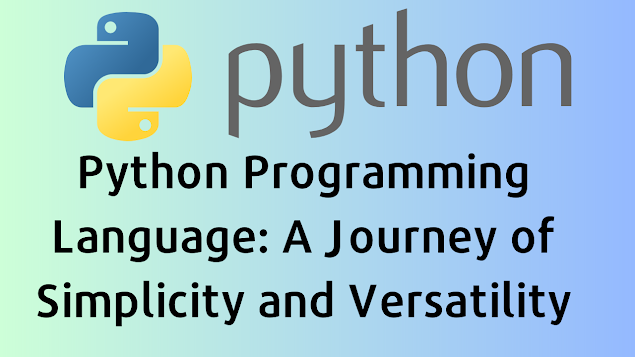Python, a powerful and versatile programming language, has made its mark across diverse domains since its inception. Created by Guido van Rossum in the late 1980s, Python was designed with a vision to prioritize simplicity, readability, and developer-friendly syntax. Over the years, it has grown to become one of the most popular programming languages, catering to a wide range of applications, from web development to artificial intelligence. In this blog post, we will take a closer look at the history of Python and explore its extensive usage in various fields today.
The Birth of Python: Python's story began in December 1989 when Guido van Rossum, a Dutch programmer, embarked on creating a language that would prioritize ease of use. He drew inspiration from languages like ABC, Modula-3, and C and released the first version of Python in 1991. Python quickly gained attention due to its intuitive and readable syntax, making it a favorite among developers.
Early Adoption and Growth: In the mid-1990s, Python gained significant traction, particularly in the scientific community. Its simplicity and support for powerful modules, including NumPy and SciPy, made it an ideal choice for data analysis and scientific computing. Python's growth continued through the early 2000s, with the release of Python 2.0 and subsequent versions that introduced new features like garbage collection and Unicode support.
Python 2.x and 3.x Split: Python faced a crucial juncture when it became apparent that certain design flaws and limitations in Python 2.x needed addressing. In 2008, Python 3.0 was released, introducing a series of backward-incompatible changes. While Python 3.x aimed to enhance the language, the transition from Python 2.x proved slow due to compatibility concerns. Nevertheless, the community persevered, and Python 3.x gained momentum.
Python's Domination Across Domains: Python's simplicity and versatility paved the way for its widespread adoption across various domains. In web development, frameworks like Django and Flask revolutionized the way applications were built, enabling developers to create scalable and robust web solutions. Python's extensive library ecosystem, including Pandas, NumPy, and Matplotlib, became instrumental in data analysis, visualization, and scientific research.
Furthermore, Python played a pivotal role in the rise of machine learning and artificial intelligence. Frameworks such as TensorFlow and PyTorch empowered developers to build sophisticated models and drive advancements in computer vision, natural language processing, and predictive analytics. Python's clean syntax and ease of use made it accessible to both seasoned researchers and beginners alike.
- Python in Modern Applications: As we approach the present day, Python remains at the forefront of technological innovation. Cloud computing platforms, including AWS Lambda and Google Cloud Functions, rely on Python for serverless computing, enabling developers to build scalable and efficient applications. Python's integration with big data tools like Apache Spark has further cemented its position in the world of data engineering and analytics.
Python's relevance extends to emerging technologies as well. Its simplicity and extensive libraries make it a preferred choice for blockchain development, enabling the creation of decentralized applications and smart contracts. Python also finds its place in the internet of things (IoT) ecosystem, allowing developers to interface with sensors, devices, and gateways effortlessly.
From its humble beginnings as a pet project to becoming one of the most popular programming languages today, Python has proven its mettle in simplifying development and enabling innovation. Its journey has seen it become the go-to language for web development, data analysis, machine learning, and a wide range of applications. Python's continued growth, active community, and adaptability to emerging technologies ensure its enduring relevance in the ever-evolving tech landscape.
As we look to the future, Python shows no signs of slowing down. The Python community remains vibrant and dedicated, continually improving the language and expanding its ecosystem. New versions, such as Python 3.9 and the upcoming Python 3.10, introduce enhanced features and performance optimizations.
Python's popularity is also reflected in the abundance of learning resources available. Online tutorials, documentation, and educational platforms make it easy for beginners to get started with Python, while experienced developers can find advanced topics and niche applications to explore.
Furthermore, Python's versatility allows it to seamlessly integrate with other programming languages. Its extensive support for interoperability enables developers to leverage Python alongside languages like C, C++, and Java, expanding its potential use cases and capabilities.
Beyond its technical strengths, Python fosters a welcoming and inclusive community. The Python Software Foundation (PSF) supports and promotes Python-related initiatives, conferences, and events worldwide, fostering collaboration and knowledge sharing among developers.
In conclusion, Python's success story is driven by its simplicity, readability, and versatility. From its origins as a passion project, Python has evolved into a programming language of choice for developers across industries. Whether you're building a web application, diving into data analysis, or exploring the frontiers of artificial intelligence, Python provides the tools and resources you need to bring your ideas to life. As we move forward, Python's influence will undoubtedly continue to expand, enabling innovation and empowering developers to create the technologies of tomorrow.
